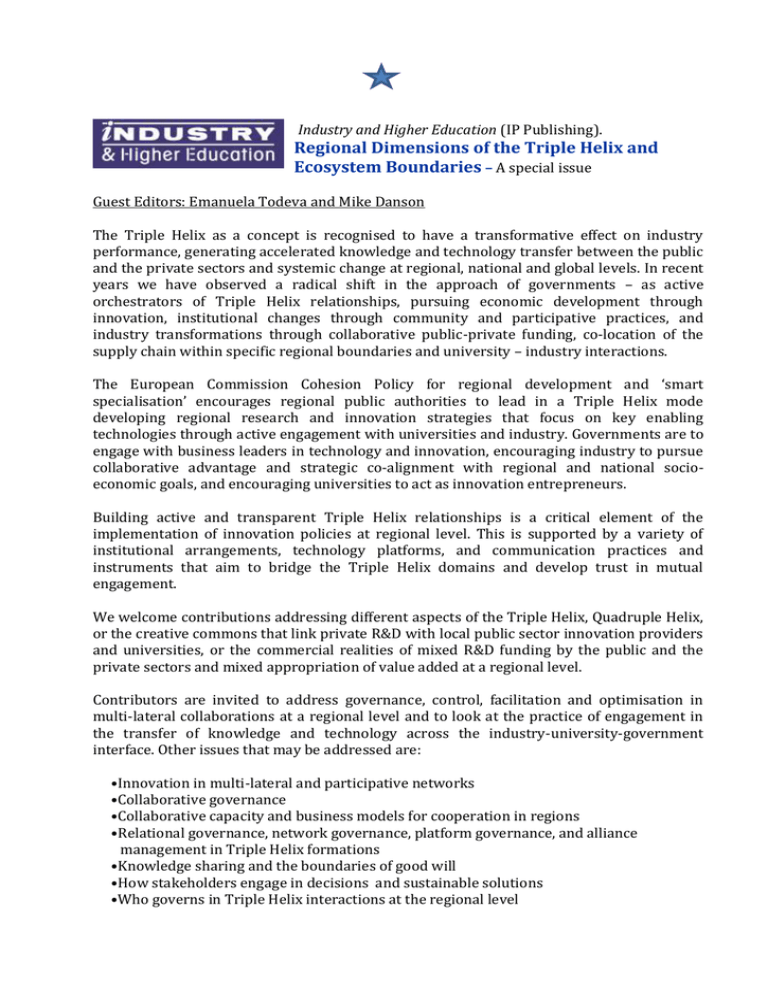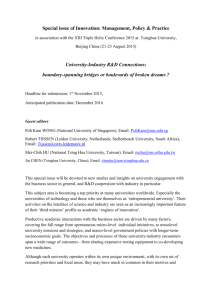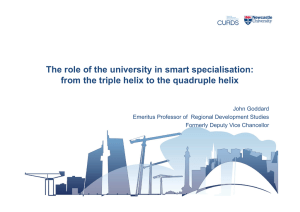Regional Dimensions of the Triple Helix and Ecosystem Boundaries
advertisement

Industry and Higher Education (IP Publishing). Regional Dimensions of the Triple Helix and Ecosystem Boundaries – A special issue Guest Editors: Emanuela Todeva and Mike Danson The Triple Helix as a concept is recognised to have a transformative effect on industry performance, generating accelerated knowledge and technology transfer between the public and the private sectors and systemic change at regional, national and global levels. In recent years we have observed a radical shift in the approach of governments – as active orchestrators of Triple Helix relationships, pursuing economic development through innovation, institutional changes through community and participative practices, and industry transformations through collaborative public-private funding, co-location of the supply chain within specific regional boundaries and university – industry interactions. The European Commission Cohesion Policy for regional development and ‘smart specialisation’ encourages regional public authorities to lead in a Triple Helix mode developing regional research and innovation strategies that focus on key enabling technologies through active engagement with universities and industry. Governments are to engage with business leaders in technology and innovation, encouraging industry to pursue collaborative advantage and strategic co-alignment with regional and national socioeconomic goals, and encouraging universities to act as innovation entrepreneurs. Building active and transparent Triple Helix relationships is a critical element of the implementation of innovation policies at regional level. This is supported by a variety of institutional arrangements, technology platforms, and communication practices and instruments that aim to bridge the Triple Helix domains and develop trust in mutual engagement. We welcome contributions addressing different aspects of the Triple Helix, Quadruple Helix, or the creative commons that link private R&D with local public sector innovation providers and universities, or the commercial realities of mixed R&D funding by the public and the private sectors and mixed appropriation of value added at a regional level. Contributors are invited to address governance, control, facilitation and optimisation in multi-lateral collaborations at a regional level and to look at the practice of engagement in the transfer of knowledge and technology across the industry-university-government interface. Other issues that may be addressed are: •Innovation in multi-lateral and participative networks •Collaborative governance •Collaborative capacity and business models for cooperation in regions •Relational governance, network governance, platform governance, and alliance management in Triple Helix formations •Knowledge sharing and the boundaries of good will •How stakeholders engage in decisions and sustainable solutions •Who governs in Triple Helix interactions at the regional level •Internationalisation of university education and the impact on regions •The contribution of the entrepreneurial university to the success of Triple Helix partnerships •Is an ecosystem region-specific or can it be replicated elsewhere? Provisional References: Audretsch, D. B., Hülsbeck, M., & Lehmann, E. E. (2011) Regional competitiveness, university spillovers, and entrepreneurial activity. Small Business Economics. Bailly A., G. Gibson, K. Haynes. (2008) Applied Geography for the Entrepreneurial University, Economica/ Brookings Baltzopoulos, A., & Broström, A. (2011) Attractors of Entrepreneurial Activity: Universities, Regions and Alumni Entrepreneurs. Regional Studies, (December), 1-16. Bathelt H. (2006) Geographies of Production: Growth Regimes in Spatial Perspective 3 Toward a Relational View of Economic Action and Policy, Progress in Human Geography, vol. 30: 223-236. Bathelt, H., Kogler, D. F., & Munro, A. K. (2010) A knowledge-based typology of university spin-offs in the context of regional economic development, Technovation, 30(9-10), 519532. Boschma, R., K. Frenken. (2011) The emerging empirics of evolutionary economic geography, Journal of Economic Geography, 11 (2), 295-307. Bramwell, A., & Wolfe, D. A. (2008) Universities and regional economic development: The entrepreneurial University of Waterloo. Research Policy, 37(8), 1175-1187. Budd, L., & Hirmisf, K. (2004) Conceptual Framework for Regional Competitiveness. University Business, Regional Studies, 38: 9, 3(December), 1015-1028. Capello R., Nijkamp P. (eds). (2009) Handbook of Regional Growth and Development Theories, Edward Elgar. Carrincazeaux C., Lung, Y., Vicente, J. (2008) The scientific trajectory of the French school of proximity: Interaction and Institution-based approaches to Regional Innovation Systems European Planning Studies, 16(5). Cohen, W M and Levinthal, D A. (1990) Absorptive capacity: A new perspective on learning and innovation, Administrative Science Quarterly, 35: 128-152 Cooke P., B. Asheim, R. Boschma, R. Martin, D. Schwartz and F. Todtling (eds.). (2011) The Handbook on Regional Innovation and Growth, Cheltenham: Edward Elgar. Cooke, P. & Leydesdorff, L. (2006) Regional Development in the Knowledge-Based Economy: The Construction of Advantage, Journal of Technology Transfer, 31: 5-15, 2006. Etzkowitz, H. (2003) Innovation in Innovation: The Triple Helix of University-IndustryGovernment Relations. Social Science Information, 42(3), 293-337. Etzkowitz, H. (2008) The Triple Helix: University–Industry–Government Innovation in Action. New York, Routledge. Etzkowitz, H., & Dzisah, J. (2008) Rethinking development: circulation in the triple helix, Technology Analysis & Strategic Management, 20(6), 653-666. Etzkowitz, H., & Leydesdorff, L. (2000) The dynamics of innovation: from National Systems and “Mode 2” to a Triple Helix of university – industry – government relations Science and Technology, 109-123. Farinha, L and Ferreira, J J. (2013) Triangulation of the Triple Helix: A Conceptual Framework’, Triple Helix White Paper, accessed from http://www.triplehelixassociation.org/workingpapers/triangulation-of-the-triple-helix-a-conceptual-framework-wp-1-2013 , 06 May 2014. Martin, S. and Mayer, H. (2008) Sustainability, Clusters, and Competitiveness, Economic Development Quarterly, 22 (4): 272-276. McAdam, R., Miller, K., McAdam, M., & Teague, S. (2011). The Development of University Technology Transfer Stakeholder Relationships at a regional level: Lessons for the future. Technovation, 1-11. Pike, A., Rodriguez-Pose, A., Tomaney, J. (2006) Local and regional development, Routledge, London. Semlinger, K. (2008) Cooperation and competition in network governance: regional networks in a globalised economy, Entrepreneurship & Regional Development, 20(6), 547560. Smith, H. L., & Bagchi-Sen, S. (2010) Triple helix and regional development: a perspective from Oxfordshire in the UK. Technology Analysis & Strategic Management, 22(7), 805-818. Stimson R., Stough, R., Roberts, B. (2006) Regional Economic Development. Analysis and Planning Strategy, Springer, New York (2d edition) Todeva, E. (2006) ‘Clusters in the South East of England’, University of Surrey. Torre A. 2008. On the role played by temporary geographical proximity in knowledge transfer, Regional Studies, vol. 42, no 6: 869-889. Torre A., A. Rallet. 2005. Proximity and localization, Regional Studies, vol. 39, n° 1, 47-60. Zahra, S A and George, G. (2002) Absorptive capacity: a review, reconceptualization, and extension, Academy of Management Review, Vol 27, No 2:185-203. Full papers (or approximately 6000-8000 words) must be submitted for publication through the IP Publishing system for the journal Industry and Higher Education, selecting the special issue on Regional Dimensions of the Triple Helix and Ecosystem Boundaries. All papers will be double-blind reviewed in that system. For presentation and style guidelines, please go to http://www.ippublishing.com/ihe.htm and click on ‘Submissions’. Submission Deadlines: Expression of Interest – please, e-mail an expression of interest containing an extended abstract of approx. 500 words to e.todeva@surrey.ac.uk before 1 September 2014 Full papers will be required to be submitted on the publisher’s site before 30 November 2014





